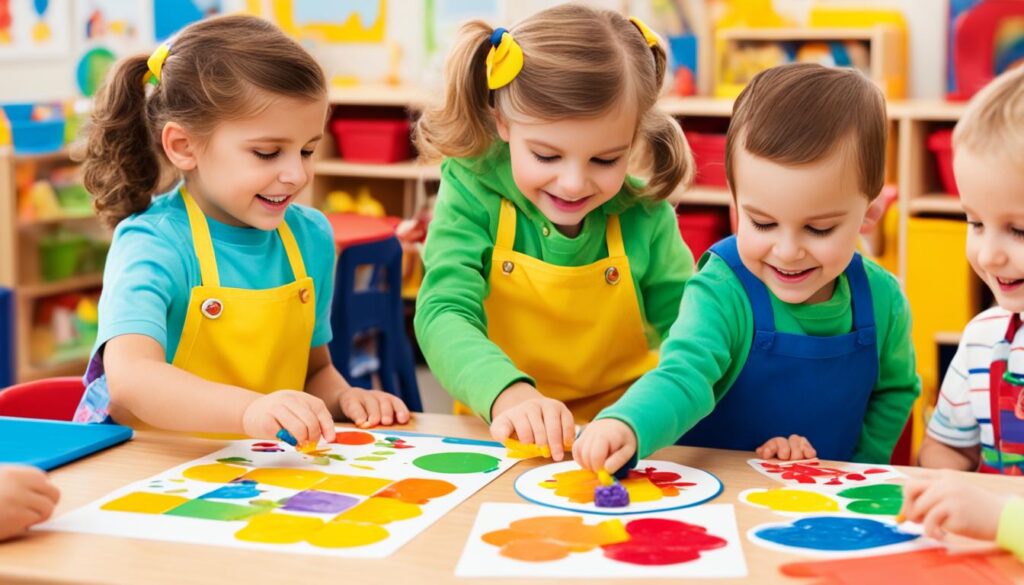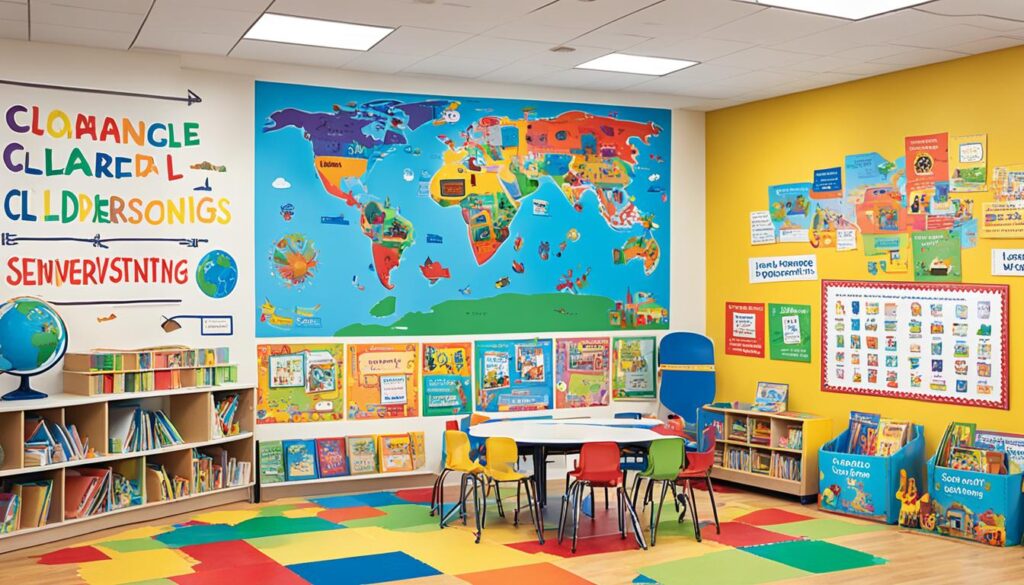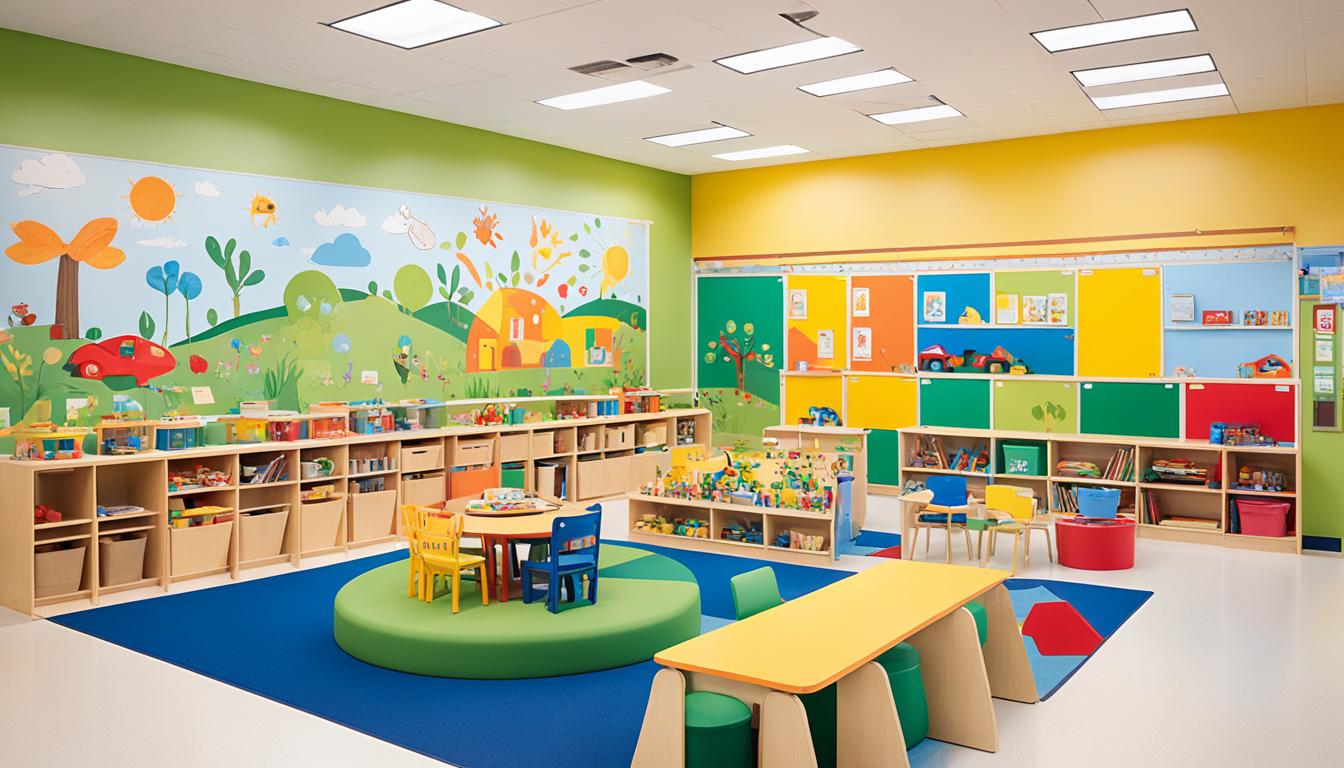Did you know the US has over 100,000 early childhood education programs? These programs cater to the diverse needs of young learners. From traditional preschools to specialized Montessori and Waldorf schools, there’s a wide range of options for parents. We’ll look into the different types of early childhood education programs, their unique philosophies, and what makes them stand out.
Key Takeaways
- The US has over 100,000 early childhood education programs catering to diverse learning needs
- Early childhood education programs range from traditional preschools to specialized Montessori and Waldorf schools
- Each program type has its own unique philosophy, curriculum, and approach to learning
- Exploring the different program options can help parents find the best fit for their child’s development
- Understanding the key features of each program type is crucial in making an informed decision
Preschool Programs
Preschool programs are key in early childhood education. They give young kids a strong start in learning and social skills. These programs are for kids aged 3 to 5 and offer different learning experiences suited to their needs.
Traditional Preschools
Traditional preschools use a play-based approach. They mix structured activities with free play. This way, kids learn by doing things hands-on and exploring their interests.
Their curriculum includes art, music, storytelling, and physical activities. These activities help kids love learning and make friends.
Specialized Preschools
Specialized preschools take a different path in early learning. They might follow Montessori or Reggio Emilia methods. These programs focus on the unique needs and interests of each child.
They stress hands-on, self-led learning. This approach helps kids become independent thinkers.
All preschool programs aim to create a caring and engaging place. They help kids grow and prepare for school success.
Daycare Centers
Daycare centers are key in offering quality care and learning for young kids. They help families that need full-time care for their children. These places provide a safe and caring environment all day. They cater to both full-time and part-time daycare needs of today’s families.
Full-Time Daycare
Full-time daycare centers offer care from early morning to late afternoon, all year. They’re perfect for families where both parents work or have busy schedules. Kids get a daily routine with learning activities, play, and rest.
Part-Time Daycare
For families needing care for a few hours or days, part-time daycare is an option. These programs are flexible, letting parents drop off their kids for certain hours or days. They focus on social skills, play, and learning that’s right for their age.
“Daycare centers are not just a place to keep children safe; they are hubs of learning, growth, and social development.”
Daycare centers aim to create a caring and engaging place for kids to grow. They focus on safety, learning, and helping kids feel good about themselves. Daycare centers are vital in shaping a child’s early years.
Montessori Schools
Montessori schools offer a special way to start learning early, based on Dr. Maria Montessori’s ideas. They focus on hands-on learning where kids can follow their interests and learn at their own speed. The goal is to help the whole child grow, in mind, heart, and body.
Montessori Philosophy
The Montessori way sees kids as natural learners. Educators create a special space that helps them explore and learn more. Classrooms mix kids of different ages, helping older ones teach younger ones and building a strong community.
Montessori Curriculum
- Hands-on, sensory-rich learning materials that encourage exploration and discovery
- A focus on practical life skills, such as self-care, cooking, and cleaning
- Integrated lessons that cover a wide range of subjects, including math, language, science, and the arts
- Emphasis on individualized learning, with teachers observing and guiding each child’s progress
The Montessori curriculum helps kids learn naturally, at their own speed. It builds a love for learning. By giving kids control over their learning, Montessori schools teach independence, critical thinking, and community spirit.
“The child is both a hope and a promise for mankind.” – Maria Montessori
Waldorf Education
Waldorf education focuses on early childhood learning with a special approach. It values play, creativity, and a caring environment. The curriculum includes arts, storytelling, and exploring the outdoors.
Children learn best through hands-on activities and connecting with nature, says waldorf education. Waldorf classrooms are cozy and spark imagination and self-expression.
Art is a big part of waldorf education. Kids do painting, drawing, music, and crafts to boost creativity and understand the world. Storytelling and play help kids grow their language and social skills.
“Waldorf education nurtures the whole child – head, heart, and hands – and helps them grow into well-rounded, confident individuals.”
Outdoor exploration is also key in waldorf education. Waldorf schools have big natural areas for kids to garden, hike, and watch nature. This helps kids love the environment and wonder at how life works.
Waldorf education is a special way to learn for young kids. It focuses on creativity, play, and nature. By caring for the whole child, waldorf schools prepare kids to think deeply, be creative, and connect with the world.
Different Types of Early Childhood Education Programs
Early childhood education programs come in two main types. Some focus on play-based learning, while others have a more academic curriculum. The choice between these can greatly affect a child’s learning and growth.
Play-Based Learning
Play-based learning lets kids explore and discover through fun activities. Teachers guide them, not just teach. This way, kids learn to be creative, solve problems, and make friends.
Academic-Focused Curriculum
Academic programs focus on structured lessons and teaching specific skills. They aim to teach reading, math, and thinking early. But, they might cut down on play and self-discovery.
Choosing between these programs depends on the child’s needs and stage of development. It also depends on what the family and the program aim to achieve.
“A child’s play is not just a pleasant pastime – it is essential to the cognitive, physical, social, and emotional well-being of the child.” – Dr. Maria Montessori
Head Start Programs
Head Start is a key early childhood education program. It helps low-income children and their families with education, health, nutrition, and social support. The program is funded by the federal government. It aims to give underprivileged kids a strong start in school and life.
Eligibility Requirements
To join Head Start, your family’s income is the main factor. If your income is below the poverty line or you get public assistance, your child might qualify. You can also apply if your child has a disability. The application process is easy, helping those who need it most.
Services Offered
Head Start programs provide many services for children’s growth. These include:
- High-quality early education that helps with thinking, social, and emotional skills
- Health screenings and referrals for medical or dental care
- Nutritious meals and snacks for good health
- Activities and workshops for parents to learn and engage
- Support and services for the challenges faced by low-income families
Head Start meets the needs of children and their families. It helps communities and sets the stage for success later in life.

“Head Start programs are changing lives, offering vital support to those in need. The comprehensive support and resources are truly priceless.”
Reggio Emilia Approach
The Reggio Emilia approach is a leading way of teaching young children. It focuses on letting kids learn by themselves and share their thoughts creatively. Teachers help guide them, but they also learn alongside the children.
Child-Centered Learning
This method deeply respects each child’s curiosity and potential. Teachers pay close attention to what kids say and do. They then create learning experiences that match the kids’ interests and strengths.
This way, kids take charge of their learning. They feel more connected and interested in what they’re doing.
Project-Based Curriculum
Kids in Reggio Emilia learn through projects that they lead. These projects start with something they’re curious about and grow as they learn more. Teachers help by providing materials and support, but kids decide where the project goes.
This approach helps kids think critically, solve problems, and communicate well. It’s known for making kids love learning and becoming confident, well-rounded people.
“The Reggio Emilia approach views children as capable, curious, and full of potential, encouraging them to explore their world and express their ideas through multiple avenues of communication.”
Bilingual Immersion Programs
In early childhood education, bilingual immersion programs are getting more popular. They let young kids learn two languages, like English and Spanish or Mandarin Chinese. This helps them become fluent and literate in both languages.
The main aim is to make kids proficient in two languages early on. By being in a setting where they hear and use both languages, they pick up the languages naturally. This sets a strong base for their future in school and life.

These programs use fun teaching methods like interactive lessons and hands-on activities. Kids learn language skills and also get to know different cultures and views. This makes them more open-minded and culturally aware.
Bilingual immersion programs are great for brain development. Studies show that kids learning two languages do better in problem-solving, memory, and thinking. They become more flexible and adaptable.
“Bilingual children are better able to focus their attention on relevant information and ignore distractions, a skill that is important for success in school and beyond.”
Our world is getting more connected, making bilingual skills more valuable. By joining bilingual immersion programs, kids get ahead. They’re ready for the future’s challenges and chances.
Conclusion
Early childhood education programs come in many types, each with its own benefits. From traditional schools to Montessori and Waldorf, there are many choices. These options help parents pick the best program for their child’s needs.
Understanding the different programs and their philosophies helps families make good choices. They can find programs that match their child’s interests and learning style. This ensures every child gets a chance to do well in their early years.
When looking at early childhood education, it’s important to look at the curriculum and teaching methods. This way, parents can give their children a strong start for the future. They can help their kids grow and learn well throughout their lives.
FAQ
What are the different types of early childhood education programs available?
Early childhood education programs come in many forms. You can find traditional preschools, specialized ones like Montessori and Waldorf, daycare centers, Head Start programs, and bilingual immersion programs. Each type offers a unique way to learn and grow early on.
What is the difference between traditional preschools and specialized preschools?
Traditional preschools mix play with structured activities. Specialized ones, like Montessori, focus on hands-on learning and self-directed activities. They also have multi-age classrooms and focus on each child’s interests.
What are the different types of daycare centers?
Daycare centers look after young children from infancy to school age. They come in two types: full-time for all-day care, and part-time for shorter hours. This helps families find the right care for their needs.
What is the Montessori philosophy and curriculum?
Montessori schools follow a method by Maria Montessori. They focus on learning by doing, having kids of different ages together, and on each child’s interests. The goal is to make kids independent, solve problems, and love learning.
What is the Waldorf approach to early childhood education?
Waldorf education values play, creativity, and a caring environment. It uses arts, stories, and outdoor activities to teach the whole child. This approach helps kids grow in a holistic way.
What is the difference between play-based learning and academic-focused curriculum?
Some programs focus on play to help kids learn through exploration. Others have a more structured approach, focusing on academics. This choice depends on the program’s goals.
What is the Head Start program?
Head Start is a program for low-income kids and their families. It offers education, health, nutrition, and social services. Kids can join if their family’s income is low, and it helps with their development.
What is the Reggio Emilia approach to early childhood education?
The Reggio Emilia method puts kids at the center of learning. It encourages them to explore and share their ideas. Teachers help guide them, acting as co-learners.
What are bilingual immersion programs?
Bilingual immersion programs teach kids two languages, like English and another, from early on. They aim to make kids fluent in both languages.
